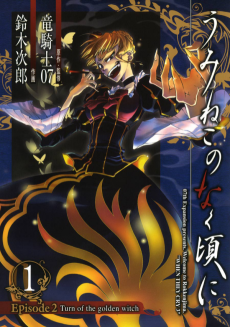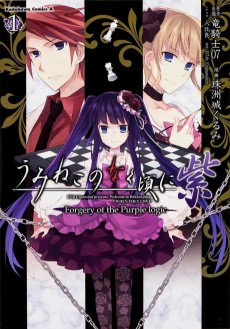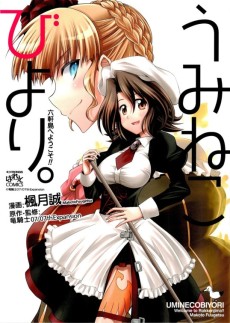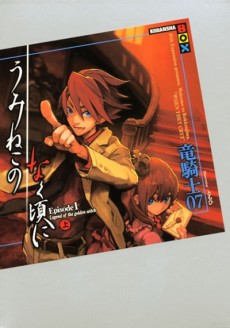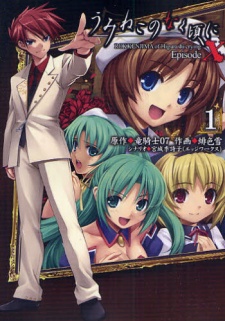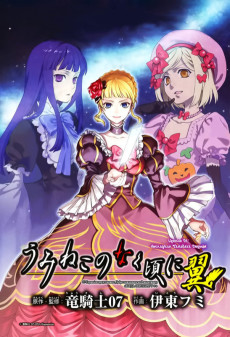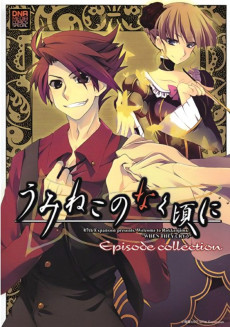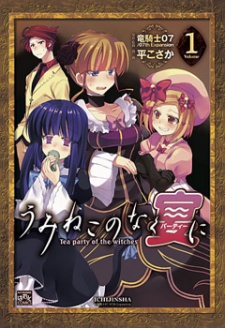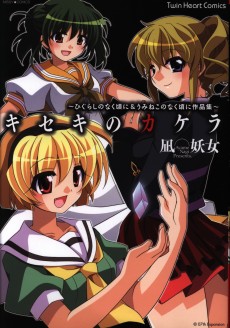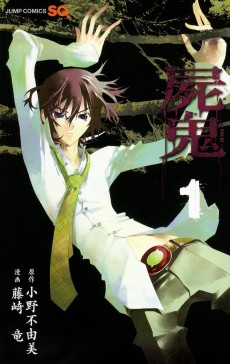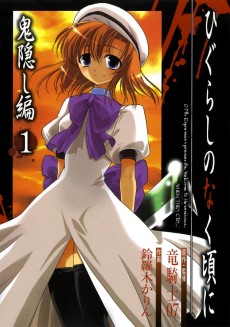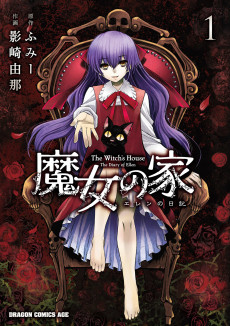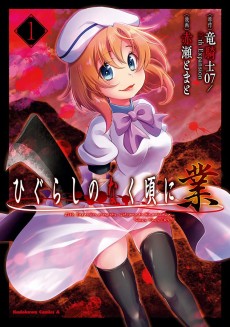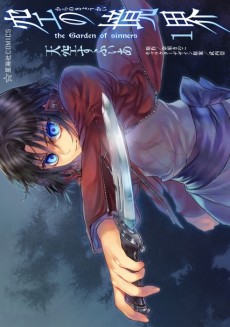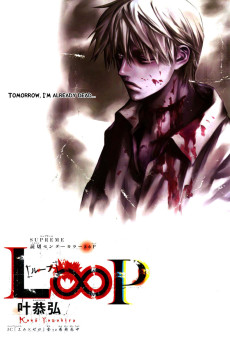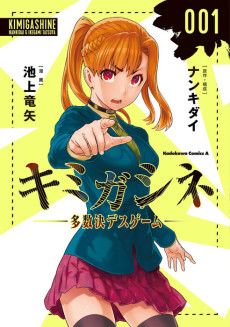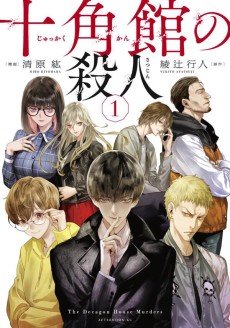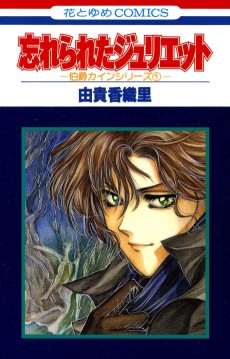UMINEKO NO NAKU KORO NI EPISODE 1: LEGEND OF THE GOLDEN WITCH
STATUS
COMPLETE
VOLUMES
4
RELEASE
August 22, 2009
CHAPTERS
23
DESCRIPTION
Each year, the Ushiromiya family gathers at the secluded mansion of its patriarch, the elderly Kinzo. It has been six years since Battler joined his cousins at the annual event, but their happy reunion is overshadowed by worsening weather and an eerie premonition from his youngest cousin—not to mention their parents’ feud over the inheritance. Battler doesn’t hold much stock in dark omens, nor does he believe the tales of the witch rumored to have given his grandfather a fortune in gold…and who walks the halls of the mansion to this day… But when the eighteen family members and servants are trapped on the island by the raging typhoon, the grisly events that follow leave Battler shaken to his core. Is one of his relatives desperate enough to kill for the family fortune? Or is this the work of the Golden Witch?
(Source: Yen Press)
Note: Volume 4 also contains the tea party chapter for this episode.
CAST
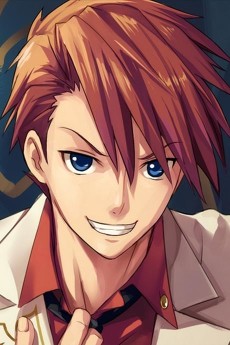
Battler Ushiromiya
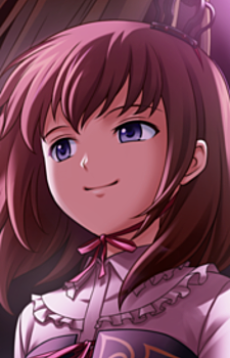
Maria Ushiromiya
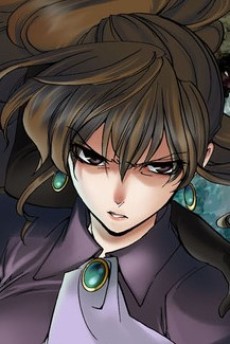
Natsuhi Ushiromiya
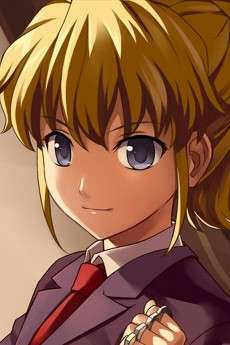
Jessica Ushiromiya
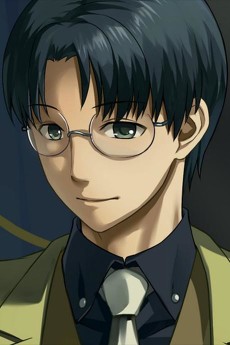
George Ushiromiya

Beatrice

Frederica Bernkastel

Eva Ushiromiya

Shannon
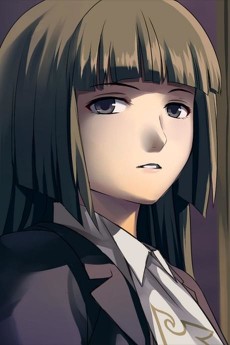
Rosa Ushiromiya
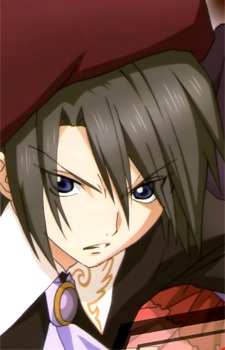
Kanon
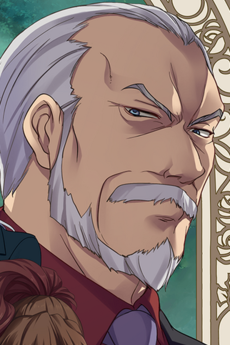
Kinzou Ushiromiya

Kyrie Ushiromiya
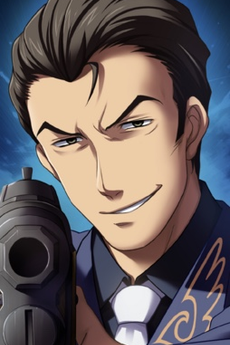
Rudolf Ushiromiya
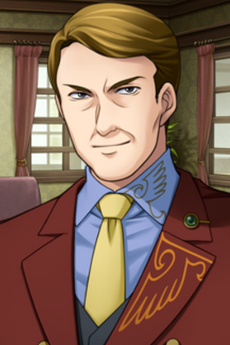
Krauss Ushiromiya

Toshiro Gouda
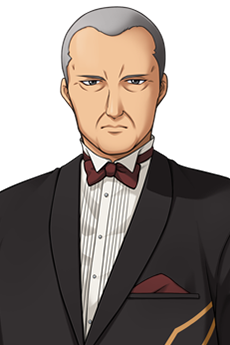
Genji Ronoue
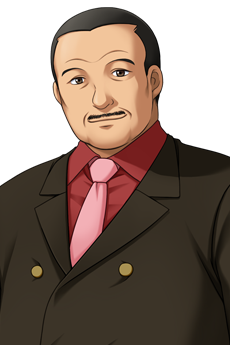
Hideyoshi Ushiromiya
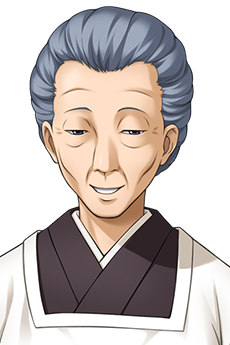
Chiyo Kumasawa
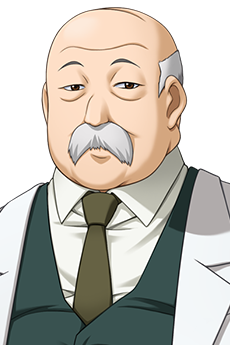
Terumasa Nanjou
CHAPTERS
RELATED TO UMINEKO NO NAKU KORO NI EPISODE 1: LEGEND OF THE GOLDEN WITCH
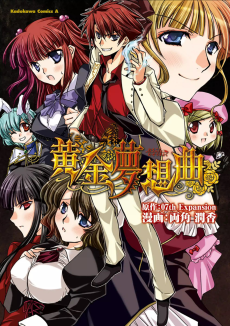 MANGA ComedyOugon Musoukyoku
MANGA ComedyOugon Musoukyoku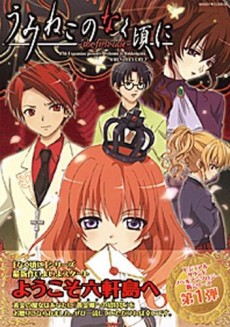 MANGA ComedyUmineko no Naku Koro ni
MANGA ComedyUmineko no Naku Koro niREVIEWS

Krankastel
70/100Part I: when the seagulls cry, there are no survivors.Continue on AniListWhat I’ll kick start might be my most challenging reviewing goal, Umineko When They Cry. Due to its complexity and current influence on me I have yet to fully digest Umineko’s overall majesty. Also, it happens that I’ve read both the original visual novel alongside the manga adaptations.
Nonetheless, I will review as precisely as possible, individual episode level and holistically. Also included is an "extra" section connected to the VN, limited to this sole review.
Note: nothing can be considered a spoiler in this review.
__[1. Let's begin with an introduction.]__ Umineko is the second installment in the When They Cry visual novel franchise and considered a spiritual successor to Higurashi. It is structured likewise in eight episodes, divided between question arcs and corresponding answer arcs of “Chiru”, the last four of which cover more clearly what is established on the question arcs.
Episode 1 functions sort of as a prologue, establishing characters, introducing the reader to key ideas and setting foundations for an overarching narrative that will only become more and more complex and intriguing with each succeeding episode.
__[2. On to the story...]__ At this stage, the story is a whodunit crime mystery with horror elements, modeled heavily after Agatha’s Christie’s “And Then There Were None”, a novel the creator Ryukishi07 cited as one of his major influences in his overall writing.
Set during October 1986, the extended Ushiromiya family gathers together in the island of Rokkenjima, where the head mansion is sited, for their annual meeting yet end up stranded due to a monsoon. Similarly to ATTWN, a series of mysterious murders occurs until little by little less and less people remain.
So what is the twist? Those murders’ executions occur in certain circumstances that hint towards the supernatural, leaving the reader and the characters in ambiguity: is it the work of a human culprit or a great witch?
Deductive reasoning is pitted against fantasy, and many people describe Umineko overall as a fight between the mystery and the fantasy genres (although this statement is not quite correct).

Either way, don’t expect crystal clear or spoon-fed answers at any question arcs. And for the whole length of Umineko, more than mere hypotheses will be required in order to grasp either the whodunit or the elementary ideas or the overarching mystery; observe, take hints, think and theorize.
The rest is to be experienced and I can assure you, the mystery is all out from this very early stage.
__[3. Continuing with the characters...]__ At this stage, they are far from the strongest card, the reader being initiated to nineteen of which all remain underdeveloped at this stage, yet it’s fair to note this is more than justifiable for three reasons. First, all are easily recognizable and memorable. Second, development is left for the next episodes.
Third and connected to the above, almost nobody introduced at this stage remains what they appear at a superficial level. One factor connected to that is the overarching theme of family. Without digging into too many details, I confidently claim that Umineko is the most radical treatment of family I’ve experienced in Japanese fiction; for example, parents are not step-sided by their offspring and are portrayed as people with warts-and-all, while running the gamut from abusive yet troubled to sweet if strict to dysfunctional but caring. On top of that, mothers assume main or even protagonist roles in various parts of the overarching story. And this is only the tip of the iceberg.
Ushiromiya Battler as a protagonist is goofy, upbeat and rather perverted at first glance, but also compassionate, quite rational and intelligent. He’s driven to confront the culprit and prevent more murders from occurring. He’s also more than meets-the-eye and should not be judged solely according to this episode.
__[4. And concluding with artwork...]__ Umineko’s story is progressively evolving and literally improving in quality with each episode. What does remain inconsistent though is artwork, for the manga adaptations are not all drawn and illustrated by the same artist. Apart from the object of the current review, its artist also drew and illustrated the 8th episode.

Character designs can be hit-or-miss and most backgrounds are simply functional, yet some powerful panels can be found and expressions are one of the strong cards of artwork. When the artwork really does shine though is during transitions to crime scenes and more disturbing expressions. Those shifts match perfectly to their corresponding scenes, and are not for the squeamish or weak of heart.
And that should be kept in mind for the whole of Umineko: be prepared for very nasty horror scenes that could shock and/or nausiate even a seasoned spectator, among others.
Hope you enjoyed my review, and hope you likewise enjoy Umineko in the future! 
VirtuousZero
80/100Let us go, to Rokkenjima of 1986; to the place where fact and fiction coalesce!Continue on AniList
__A Brief Preface__ This review will not only be a review of the Umineko manga episode 1, but also its visual novel counterpart. I will review both, mention a few interesting things about each, and in the end, give scores for both separately.
The score in the bottom quadrant reflects my VN score, as it is a more accurate representation of my thoughts on the series and all individual episodes.This review will also contain spoilers on episode 1, so if you haven’t read it, kindly do so before reading this review.
__The Story__ Umineko’s plot follows the affluent family of Ushiromiyas during the two-day period of the annual family conference which occurs on their privately owned island named Rokkenjima. I will not give any greater story summary than that as this review is written with you, the reader, already knowing the story in mind.
So this episode, being the introductory one to Umineko’s world, is extremely slow in getting to the serial murder mystery game, in fact, if you read it knowing nothing about it, I honestly couldn’t blame you if you were surprised when, halfway through, murders start occurring. So the way Umineko positions itself is as a game between the author and the reader, this isn’t something that is immediately made clear, but anyone moderately quick on the uptake will likely realize it by the end of this episode. There are 18 people on Rokkenjima by the time the serial murders start happening, and it is cut off from the rest of the world by a large typhoon. Thus, with no police, no forensics or any semblance of modern technology, you are meant to ascertain which of the 18 individuals on the island is the serial killer. It should be made clear that you are not meant to solve the riddle by the end of this episode, as there are 7 more to go, while solvable at this point, it is extremely difficult.
However, Umineko is not merely a mystery, it is also a story. You may find this observation redundant, “of course Umineko is a story, what else could it be?” , so let me justify this claim. Now, I am by no means a connoisseur of the mystery genre. However, in my experience, slight as it may be, mysteries generally tend to scrape all manner of characterization and emotional writing in pursuit of this one truth which lies at the end. They are better looked at as riddles than actual stories with characters who inhabit them. Umineko, much to my delight, dispenses with this notion and fleshes out its extremely lovable, although highly flawed and extremely jaded cast of characters. There is heartfelt writing, interesting character dynamics and many sorrowful and joyous peaks interspersed amidst the mystery and the profound meta commentary on the nature of the genre. What I mean to say here is that Umineko is far more than your run o’ the mill mystery, and so long as you enter with that mindset, I think you’re bound to appreciate it much more.
Now, I’ve talked at moderate length about what Umineko is and how you should approach it. Now before I take a crack at the characters and talk about them individually, let me mention some of Umineko’s flaws which may dull the experience.
So firstly, the pacing, as you can expect from a 100+ hours story (significantly less if you read the manga instead) this is not a story that will be kind on your time. Some parts, especially the ones more focused on slice of life scenes, tend to slow down the story to a crawl. And yet, it isn’t only limited to them, sometimes, mystery-related info-dumps overstay their welcome.There is an instance, somewhere 3/4ths through the story where a corpse is discovered in a furnace, the corpse happens to have polydactyly, a medical condition of having six toes essentially, and while this, at face value, needs little more than a couple lines of prose to be explained, Umineko breaks down into a full-blown study of polydactyly, its implications, and all manner of mumbo-jumbo that is not associated with anything of relevance. While this condition should have been used merely as a means of identifying the owner of the corpse, it forays into one of the most mind-numbingly boring discussions I’ve been privy too.
There are many more cases like this, and manga handles it better than the VN, as it naturally has better pacing by the virtue of visualizing the things that have to be explained in the VN, not to mention that the author is not particularly good at condensing his prose down to a more digestible level, and what you have is an overtly bloated style of writing for a piece of fiction that is already extremely bloated on its own. Now, I am a great admirer of density in fiction, all my favorite fiction is somewhere between ten to thirty hours long, so I will concede that in this regard, I am innately biased against Umineko, and you may find its pacing way more agreeable than I did.
Another thing I didn’t like is how the tropey Japanese dialogue and the fact that the main character initially comes off as a pervert mislead you into thinking Umineko is just an average VN with a mediocre protagonist. It markets itself very poorly in the first few hours. Now hear me out here, I am unfortunately not 5 years old and do not find the gropey humor of Umineko’s first episode particularly entertaining. In fact, it led to frequent facepalms during my Seven Deadly Sins readthrough and its safe to say that I derive no enjoyment from it. However, let me also say that the main character of Umineko isn’t actually like this, and merely likes the interaction of getting slapped as he ‘goes in for the kill’ metaphorically speaking. This is still a bit too… anime for my liking, but far more digestible than what Meliodas does. The dialogue gets miles better in the following episodes, but for this one specifically, it feels like it could have been tackled more elegantly. My complaint here isn’t that Umineko is too anime (vague as this criticism is) but rather that it initially markets itself as such, which I do not like.
Now, what I failed to mention previously is that there is one more great mystery besides whodunit/whydunit/howdunit, and that is the Golden Epitaph of the witch Beatrice. Solving this epitaph is supposed to grant the solver 4 great treasures, an entrance into the golden land, and all the family wealth of Ushiromiya family, which was bestowed unto Kinzo Ushiromiya (The head of the family) by The Golden Witch, Beatrice. The epitaph also casts allusion to the murder game with its third section, and it is under this pretense that murders are, according to epitaph, split into ‘twilights’. Epitaph states that you should kill 6 people during the first twilight, tear apart 2 who are close during the second, and going further, kill in certain ways (gouging head, chest and so forth) for the following twilights, totaling up to 13 victims.
The text below is in reference to the solution of the epitaph, kindly do not open unless you already don't know it/are way too curious to contain yourself.
Now, calling the epitaph a “great” mystery was a stretch on my part, as if you don’t know Japanese kanji, it is completely unsolvable, as it's essentially a Japanese word game. So if you don’t speak Japanese, it’s honestly perfectly fine if you are unable to solve it, I am saying this because some readers think that their inability to solve mysteries is a reflection on their intelligence, and end up enjoying the work less. Naturally, even if you speak Japanese, the riddle is still ridiculously hard and is by no means a reflection on your intelligence in the slightest, I think this is a riddle that was not meant to be solved by us, the readers, but that’s just my opinion.I think the pacing between twilights is quite solid in this episode and the first twilight marks the start of Umineko proper, I will not talk about the deaths nor circumstances here, but let me say that the author posits some quite interesting scenarios and will give you mental tools to solve them on your own later on. The end contains a 4th wall-breaking section known as the Tea Party and the ???? section, also called the Hidden Tea Party, or Tea Party of inhumans. Now, the ???? section is where Umineko truly engaged me, it comes at the very end of episode one and features a discussion between 3 great witches, and just seeing how these infinite beings bounce off of each other as they discuss various metaphysical principles on which the Umineko world is founded was fascinating to me.
The Tea Party which occurs just before that lays out the actual premise of the story, which is Beatrice challenging Ushiromiya Battler (The main character) to a battle of wits wherein he tries to prove that the murders were done by a human hand, and she tries to prove that it’s all witch’s doing. This is why every murder scenario is seemingly impossible at first, makes working out the howdunit extremely fun.
__Characters__ Ushiromiya Kinzo
The head of the family, I like this character a lot. He gives me the same vibe of an extremely imposing character like Charles zi Britannia from Code Geass. There is an air of madman’s genius about him, also, characters who contend with fate are one of my favorite archetypes so I took a liking to him rather quickly.
Kinzo’s Children
Kraus isn’t particularly interesting, his role in the story barely ever lives up to what you’d expect of the heir to Ushiromiya family. Eva is extremely complex, although this episode will not lay her character out particularly deeply. Rudolf is mediocre, and Rosa has yet to come into the amazing character she will become by the end of episode 4.
The spouses of Kinzo’s children
Natsuhi, contrarily to some of the other characters on here, is almost immediately engaging. She has an inferiority complex spurred on by Eva as she is repeatedly told that she isn’t a ‘true Ushiromiya’ and merely a ‘borrowed womb’.
Kyrie acts as Battler’s step-mom although they have a much friendlier relationship than that. She also acts as his mentor before the twilights unfold and teaches him basic problem solving. She likens mysteries with chess, stating that ‘flipping the chessboard’ (which is a fancy way of saying that you think from your opponent’s perspective) is a good way of solving mysteries. This chessboard flip will become Battler’s signature move in his oncoming bouts with Beatrice, and it’s really cool how she is always a part of him, regardless of whether she is there or not. In case you couldn’t tell, I really like this character.
Hideyoshi, being Eva’s husband has an interesting role. Initially, he is very unassuming and performs the role of the cool uncle for the other children of Ushiromiya household. Where he shines however, is when he is alone with Eva and unravels the parts of her personality which go beyond her being an asshole to everyone and her tongue-in-cheek demeanor. I consider him more of a complementary character to Eva than a full-on one in his own right.
The Servants
Genji, Gohda and Kumasawa do not play big parts in this episode, I will discuss them at a later point.Kanon and Shanon I find to be extremely boring even as their character arcs are peaking, I am not particularly fond of them. Their arcs seem to be about becoming human, as they are constantly referred to as “furniture” in the Ushiromiya household, but Kanon is far too edgy for my liking and Shanon is far too plain to be likeable. I find them both thoroughly mediocre.
There is also a family doctor called Nanjo, he is an uninteresting side character, although there are some decent moments between him and Kinzo, and as a foil to Kinzo, you could say he adds value to Umineko as a whole.
Kinzo’s Grandchildren
Battler is the main character and an absolute GOAT, he plays the part of Beatrice’s rival throughout Umineko’s story and their dynamic is one of the most interesting parts about it. He is carefree and energetic but also quite smart.
Maria is also an excellent character, although you won’t see that this episode, in which she comes off rather creepy. She has in-depth knowledge on the occult and waves it as a flag of pride, and frequently encourages everyone to believe in the Legend of the Golden Witch, stating that Beatrice is a close friend.
Jessica and George have unfolding relationships with Kanon and Shanon respectively, and much like those two, I do not particularly like these two either. I find all 4 to be a quartet of abject mediocrity and their inner dynamics are of little interest to me. That being said, they do have their emotional moments here and there.
The witches have far too little screen time this episode to be properly discussed, but we will discuss them and their role whenever I review episode 2!
__Sound__ _This obviously refers to the VN, and not the manga_. We can break down Umineko’s sound in 3 parts, voice acting, SFX, and OST.
Voice acting is stellar, nothing short of a masterpiece. All characters sound distinct and the way that voice actors change their cadence and manner of speech depending on what is going on is nothing short of commendable. For example, you will have scenes with Maria where she is an innocent sweet girl, and certainly sounds the part, and you will also have scenes where she is this occultist mastermind who brings unease and disarray by voice alone. The sheer range most of these characters bring tells you that every VA brought their A game for this. Another stellar example is Kinzo who usually has a commanding voice and an imposing tone, yet breaks into tears at so much as a mention of Beatrice, the VA really sells fickleness of Kinzo’s nature to the absolute best of his ability, and what we have is a standout performance. Other amazing performances include but are not limited to: Battler, Rosa, Natsuhi and Kyrie.
The SFX work of the visual novel is nothing short of a marvel. Almost every effect relating to the super-natural is instantly recognizable as something that belongs to Umineko. The SFX of golden butterflies passing by, for one instance, is very easy to recognize. There are others which are relegated to future episodes like the sharp cut of the red truth, but we will talk about those when we get there.
The OST is the single most marvelous thing in existence, but this episode, in my opinion, does not yet sell the full range of the OST well, that comes mostly by episode 2 and keeps expanding later on. Two of my favorite OSTs this episode were Worldend, played when George proposes to Shanon, and Prison Strip, played when Battler accepts Beatrice’s challenge, resulting in one of the most badass scenes in all of fiction. I will talk more about the OST in the following episode, as that’s when the real heavy hitters start coming in, but this episode is an excellent demo reel of what will become one of my favorites OSTs of all time.

__Art __ The art of Umineko's manga is the very thing which makes deciding your medium of experiencing it a tall order. While the VN certainly has some downright gorgeous CGs, the manga as drawn by Natsume Kei is one of the most visually striking pieces I'd had the pleasure to experience. This is what I would deem to be the Tragedy of Umineko, if you go for the VN, you are missing out on the manga's godtier visuals (which I will be exhibit shortly), whereas if you go for the manga, you're missing out on the amazing soundtrack of the VN.
Exhibit A 
Exhibit B 
Exhibit C 
Exhibit D 
Exhibit E 
__Summary__ Episode 1 of Umineko is an amazing introduction to the world of Rokkenjima, and you can experience it in two almost equally amazing entries. While bogged down by slow pacing and some characterization that falls flat, this story will likely leave you reflecting on it for a long time to come.
The VN score for episode one is: 80/100 The manga score for episode one is: 75/100 
FFFridge
85/100It's Good - A short, spoiler free and practical reviewContinue on AniListI try to keep these short, spoiler free, and easy to digest.
I'll start by listing everything you need to know, and if you are still interested, you can read the rest of the review.
Also, this is a review of the entire series, not just this first part.Reasons to read:
- Debating as a major story element, beat them with facts and logic (and rulelawyering)!
- Fantasy elements are legit "fantastic" and don't rely on tropes of the genre. The setting is so detailed it could be used for a full-fledged adventure story
- Mystery that manages to surprise you many, many times
- Good art and designs
- Proper ending
Reasons to not read:
- Long (LONG)
- Can be confusing
- Occasional edge
- Local inconsistencies (which are consistent in the over arching story) can be frustrating for those who enjoy theorizing, as it feels like you got cheated
- Gore, abuse, and other depressing stuff
- Main characters are sometimes geniouses and other times complete idiots. Usually it's not that bad, but it can get annoying at times.
- Switches genres in some parts of the story, for example to Shounen. It always switches back to mystery-horror and it always makes sense in context, but this can be a turnoff for some people
More Details:
Personally, I like Umineku. I like it a lot.
It's a fantasy murder mystery that tries to let both "facts-n-logic" and "lol-it's-magic-don't-think-about-it" coexist, and for the most part, it succeeds.
Also, unlike most mysteries, it actually sets up the clues for resolving the mystery over a long time, giving the reader many chances to realize the truth themselves, instead of just pointing out that the one tiny detail you skimmed over was the key to everything.
Another point in favor of Umineko's mystery is that when something seems to be incosistent, it is later on acknowledged by the characters themselves and used as a story element, which is a very unique writing style. It's like when the teacher makes a mistake, and then when asked about it they say "I was just testing to see if you would notice". In the end, it all connects together and makes sense.For the most part, the manga revolves around the mechanics of a unique game - a debate where the judgement is objective, where one player knows all the true facts but has to convince the other player in the truth of a specified fake reality. And at the same time, the other player, who has close to no knowledge on the actual reality, must use logic to disprove every one of the fake facts and find a plausible truth to win the game. In this case, the player holding the real facts must prove that magic was the murder tool, and the other player must disprove it and find a murder method possible for normal humans.
The biggest strength of this unique game is that, for the most part, the "power" escalation is actually an escalation in the difficulty of the mystery. Thanks to the challanges being intellectual, there's no powercreep, and the growth of the main character feels earned - because you, the reader, are undergoing the same growth, learning and applying your newly acquired knowledge in the same way as the main character.
If you enjoy debates and rule lawyering, you will likely enjoy the hell out of this.The characters are all fleshed out, and most of them are not tropes.
Due to the nature of the debate game, every character is a possible suspect, and therefore every character has darkness that could act as a motive for murder.
In that sense, every character in the series is edgey and a drama queen to some degree. I usually don't like this sort of stuff, but with the in-universe excuse of "You're lying, this is fake, that character would never do that", suddenly this sort of writing becomes a great tool for painting the same character in multiple, contrasting colors that force you to doubt new information and previous knowledge. Maybe what you saw until now was the fake truth?The art is pretty good too.
Consistently detailed backgrounds, great character designs, magnificent facial expressions, and very nice paneling.However, this series isn't without it's flaws.
The story is goddamn LONG. It's full-length is equivalent to a long running shounen. And don't go in hoping to read just the first part, it isn't like Jojo's Bizzare Adventure where every part is almost a full-fledged-story. The story gets twisted at the end of every episode, with the following episode continuing where the previous left off.
Another minus of the story is that, for the sake of setting up future plot twists, sometimes it just drags on or gets too confusing to keep up.
Also, sometimes absoloutley normal characters turn out to be chuck norris levels of power. It's like a shitty fan fiction, and while it is important for the plot and makes sense in the rules of the debate game, sometimes it is a bit too much for my suspension of disbelief.About the ending (spoiler free).
Endings are important. And for some reason, most mangaka can't into satisfying endings.
Umineku did a pretty great job at giving proper closure to all characters, and it didn't do it in one go too, so you have a proper breather between each character's departing to actually feel the impact.Closing thoughts:
Pretty great for those who enjoy debating all day, and can handle very long mysteries.
85/100
Minus points mostly for the main characters being a bit incosistent in their behaviour.If you decided to read the manga, here's some advice:
- Don't watch the anime, it's not that great.
- You should watch the OP and ED of the anime, they are amazing.
- Compared to the visual novels, this is a very faithful adaptation. The differences being that it is shorter, and fully reveals the solutions to some mysteries later on in the story, instead of just implying them like in the VN. So it's less confusing. But it does mean less tinfoil hat theories, which may be your thing.
- The VN has beautiful OPs for each episode. They are like cool trailers that help you get hyped for the next episode and make you theorize about the implications of cryptic symbolism. I recommend watching the OP for the episode you are starting to read.
- Don't look farther than the current episode you are in. A big part of the experience is to think "So this must be the finale" through half of this series. If you are aware that there's a "next episode", you are ruining yourself some major surprises. If knowing "how long the series is" is critical for you to decide if to read it or not, than it probably is too long for you.
- At the end of one of the middle episodes, the story seems like it fully closed. Don't be fooled, there's more! At the end of every episode always make sure there's no next one.

SIMILAR MANGAS YOU MAY LIKE
 MANGA ActionPandora Hearts
MANGA ActionPandora Hearts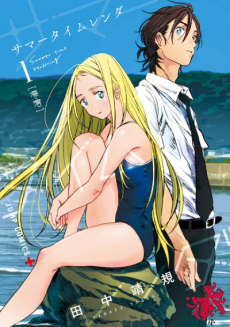 MANGA ActionSummer Time Render
MANGA ActionSummer Time Render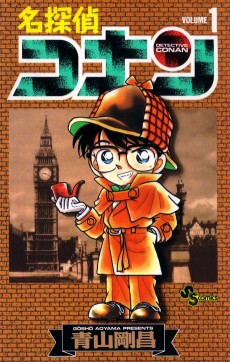 MANGA AdventureMeitantei Conan
MANGA AdventureMeitantei Conan
SCORE
- (3.7/5)
MORE INFO
Ended inAugust 22, 2009
Favorited by 361 Users


